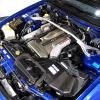How does HICAS get YAW-RATE FEEDBACK in an R33????
Announcements
-
Similar Content
-
Latest Posts
-
By Dose Pipe Sutututu · Posted
Lighting in the shed looks real good! Not lying, have shed envy lol. Maybe one day I can fk off from Metro Sydney. -
By Dose Pipe Sutututu · Posted
I would be cautious with those 2000/2200 CNG injectors, swap them out for a set of 1550 aka 1650 Bosch stainless ones before you take out a motor. -
By TheOrangeSkittle · Posted
I tested them all a couple times, haven't tested it warm or wet though. The only seemingly really weird thing was the cylinders plug closest to the dash was pitch black nearly. Doesn't smoke out of the exhaust or anything. Also sorry everyone for the very late response. Got busy with work and all and didn't get around to fooling with the car for awhile. But an update! I figured out the cause of the lean condition, my intercooler had at some point exploded or something. It's clearly separated in a spot with black oily buildup around the leak, and multiple leaks in various vacuum lines. I've replaced it and the vacuum lines, and gotten new clamps and there are 0 leaks now after doing a couple smoke tests. The car now runs significantly better and the exhaust doesn't overheat anymore. I still have the main problem though where the engine feels like I'm lugging it around sub 3500rpm in any gear besides 1st, 2nd It's less noticeable but 3rd anything under 3.5k and I need to downshift or the engine is clearly struggling when trying to accelerate at all, 4th is the exact same, sub 3.5k engine won't accelerate and its hard to bring it back up to speed, 5th gear doesn't feel like the car is going to straight up fall apart now but it still can't pull 5th. It slowly loses speed and rpm and ANY gas I give I can feel the shakes from the engine and it slowly dying. If I ever so lightly give it gas it will slowly and nicely decel till around 2k rpm instead of lugging. But it cannot accelerate at all or maintain speed. If I go from first gear at 5 or 6krpm and then shift to second it also feels like it's struggling to make power till above 3krpm if trying to accelerate but I can cruise around parking lots at around 1-2krpm just fine in 2nd. It's just when accelerating hard it and changing gear you really notice it die down. But even if you shift at way lower rpms it does the same thing till somewhere above 3k. As far as I'm aware it's got r32 gtr transmission gear ratios with gts4 diffs. The tire size is 205/55r16 91h Above 3500rpm the car pulls and runs and drives quite normally and the power from engine sounds and feels very smooth. It's perfectly driveable at above 3.5krpm but I drive on the highway alot for work and it gets really bad gas mileage in 4th at 4.4krpm. Not that I'm looking for great gas mileage with such a car, just I'm sure being at around 3krpm would be significantly better for it. Have appreciated all your guys help. I do understand the engine may just be f**ked from running with a boost leak though. One final thing I'd like to add is I'm only shifting so high in the rpm range is because if I don't I will feel the engine lugging bad with 0 power in lower rpms, pretty much anytime off boost trying to accelerate it feels really bad. Also when I say 3500 rpm I don't mean exactly. Just around there. -
So what did you end up doing ? and is it still alive today ?
-
I run 2 x 525 pumps on factory 8mm fuel lines ... zero issues, staged of course Your setup should work fine, all you need to do is find the restriction. A good aftermarket fuel regulator is always a good idea too. If it's not your regulator i'd be suspicious of your fuel tank breather and your tank pressurising. Next would be something with the fuel hat. Then blow out the fuel lines.
-








Recommended Posts
Create an account or sign in to comment
You need to be a member in order to leave a comment
Create an account
Sign up for a new account in our community. It's easy!
Register a new accountSign in
Already have an account? Sign in here.
Sign In Now